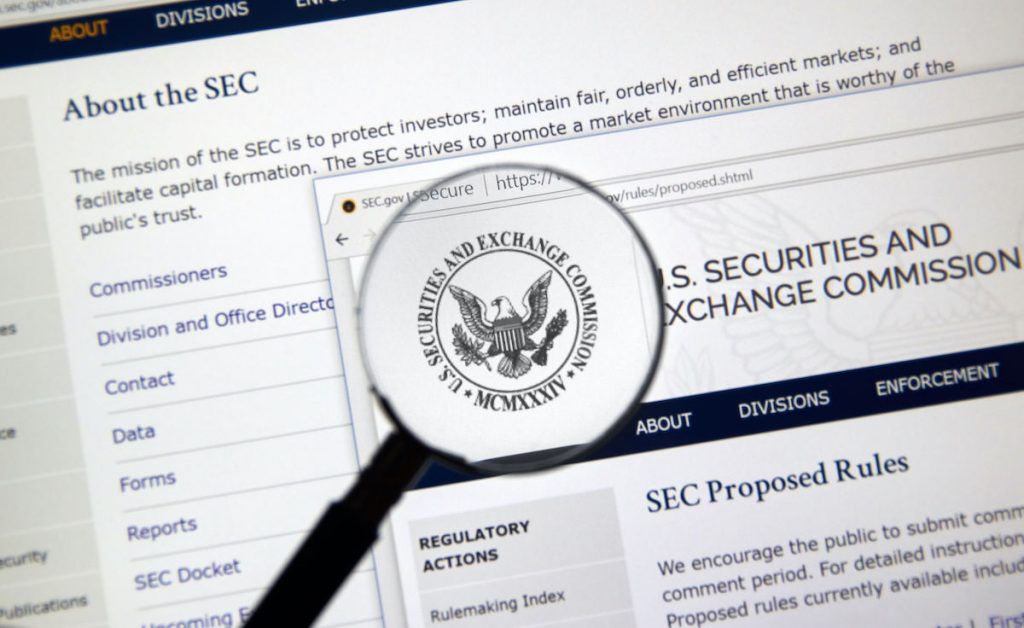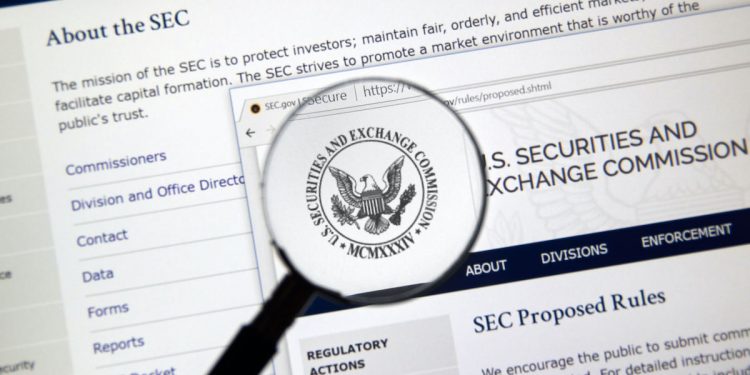Form 4: Statement on Beneficial Ownership is a two-page document to disclose the latest buys/sales of company stock and the exercise of company option rights. The information must be entered by insiders on the documents and include their holdings in the company after a transaction and the reporting person’s relationship with the company. The federal securities laws require certain individuals known as insiders, including officers, directors, and beneficial owners who hold more than 10% of any class of a company’s stock, to report purchases, sales, and holdings of their company’s shares by filing Forms 3, 4, and 5.
Every public company in the United States is required by the Securities Exchange Commission (SEC) and Securities Exchange Act to submit an annual statement of its financial results on Form 10-K. In addition, quarterly reports must be submitted for each of the first three quarters with a final number submitted at year end which captures all financial activity throughout the prior year. This information is extremely valuable for investors as it provides current and potential shareholders with a snapshot of what has been happening from quarter to quarter or year to year.
However, there are other forms that companies also have to file. The reason that this can be beneficial for investors looking into investing in or researching a particular company is because it details any transactions where insiders have increased or decreased their ownership stake in the company. This statement is filed every time certain events happen, which include:
– Purchases and sales of a company’s outstanding stock by officers or directors of that company
– The granting of options and restricted stock units (RSUs) to officers or directors
– Transfers of shares between family members or others who might be considered an owner of the company
All of these would trigger investors to go over in more detail because it could provide some insight into whether a company insider at the firm are motivated about the current direction and future potential for that business. With this, you can definitely gain more confidence as an investor if insider trading and insiders have been buying up shares during times when share prices are down. If they haven’t purchased more stock in the company, you may want to stay away as it could indicate that there isn’t a lot of confidence in future potential.
If insiders have been buying up shares through insider transactions during times when share prices are down and selling off during times of high share prices, this can also provide some insight for investors. If they haven’t bought more stock or sold their stake in the company, you may want to wait before investing yourself as it can indicate that there isn’t much faith in future potential. Insider transactions provide valuable insight.
On the other hand, if insiders have dramatically increased their ownership stake with insider transactions at a time when the share price is depressed and hasn’t sold any of those holdings yet (except under extreme circumstances), this may signal that they think things will turn around soon enough. At this point, it would be a good idea to start doing your own research on the company before considering whether or not you should buy in yourself.
Every year, Form 4 must be submitted by February 2nd for any transactions that have taken place between December 1st of the previous year and November 30th of the current one. Any changes that have been made to ownership (meaning how many shares are owned personally rather than in a fund) since the last filing must also be included.
If a director or executive has increased their holdings during a time when share prices were low, investors should consider buying then as an insider is indicating confidence in future potential. If they haven’t bought more stock during times prices were down but continue to hold their stake, it may be a good idea to hold off investing until the share prices have bounced back or indications of future growth are clarified.
If an insider has dramatically increased their ownership stake during an already depressed time for shares and hasn’t sold yet, this signal that they think things will turn around soon enough.
What is SEC Form 4?
This form is a filing that must be submitted to the Securities and Exchange Commission (SEC) every time someone who is required to file it has made or experienced certain changes regarding their ownership stake in a company. This acts as a statement of any transactions where someone has increased or decreased their ownership stake in the company, whether through an exchange of shares between family members or by purchasing stock on the open market. The form requires detailed information about the reporting person’s relationship to the company and details about their purchases and sales of equity securities. Since this form details whether insiders are buying or selling and how much they are buying or selling, it can provide insight into what direction they think the company will go in future and if now would be a good time for investors to buy in themselves.
Every year, it must be filed by February 2nd for any transactions that have taken place between December 1st of the previous year and November 30th of the current one. Any changes that have been made to beneficial ownership, meaning how many shares are owned personally rather than in a fund, since the last filing must also be included.
As an individual investor, this information could help you decide if it’s a good time for you to buy into a company that insiders may be increasing their stake in or if they sell during investment highs, it can indicate that they don’t believe future potential is high enough to warrant buying more stock. It can give investors even more confidence and potentially lead them towards making higher returns on investments as they will know exactly what direction insiders at a company are going in.
As an investor, this is information you should be aware of as it allows you to have a deeper insight into the minds of those who run or lead the companies you invest in before investing yourself. If insiders buy during times when share prices are low, it could signal that they think things will turn around and their belief will positively affect future returns on investment for investors like yourself. Since insiders know more about the company than other individuals investing, it’s worth paying attention to what actions they take with their stock if you want to increase your own returns on investment.
Many companies list specific instructions on how to submit SEC Form 4 online through filing services like EDGAR Online or SmartFormUSA. You can find this information for a company by typing “SEC Edgar” into a search engine along with the name of the company.
While every year’s filing deadline is February 2nd, it’s often best to file as early as possible because, should there be any discrepancies in the information you submit, you won’t have to wait until after companies report earnings or complete other events that may cause stock prices to change before you are notified and can fix them.
When filing by hand, paper copies need to be mailed on or before the same date each year. When using this method, mistakes could potentially result in your submission being rejected and not allowing for corrections later so it’s best just to file online whenever possible.
It also helps if you plan ahead and have all the information you need to complete the filing before sitting down to do so. You will be required to enter a company’s SSN or EIN and your own name and address as well as some other personal information that can be used to verify your identity. If you seem unfamiliar with either of these numbers, it could cause delays in processing the transactions which would push the deadline back even further. The reporting person is also important along with transaction date.
If you have any questions or want assistance filing it online, there are companies that offer this service for a fee that may be worth paying if you aren’t completely familiar with doing so yourself or simply don’t have time at the moment. While it is possible to file on your own, it’s best not to take any chances, don’t waste a business day, document at the time of earliest transaction and submit it with the help of a professional to make sure there are no mistakes.
What triggers a SEC Form 4 filing?
SEC Form 4 has to be filed any time an individual experiences a change in beneficial ownership of a security. The form must be filed before the end of the second business day following the day on which a transaction resulting in a change in beneficial ownership has occurred. When filing this, you must indicate the percentage of security being affected along with what specific transaction is taking place and how long you or your company have owned it.
One example would be if you were to sell shares that have been in your possession for at least one year which is something referred to as the 1-year rule. Since one requirement of filling out is how long you’ve had the stock involved, if you sold shares within one year of purchasing them then no filing would be required until after 12 months had passed since when their ownership first began unless further transactions took place before then that altered them enough for another filing to be required.
If you experience any increases or decreases in your ownership of a security that is not the result of trading, it’s also necessary to submit a filing. Increases are typically filed if you receive additional shares while decreases would be done if you sold more than you bought during a single year or when other transactions create major changes in your holdings.
Keeping records of all transactions can help make the process much easier and avoid delays since it would then be possible to see where things stand at any given time by looking over past filings without needing to look into each individual transaction that took place. For instance, if several transactions have taken place within one year that don’t add up to 100% then it can be difficult to determine what needs to be filed based on the requirements without first reviewing all relevant information.
Since this is a requirement for filing, it’s possible that some individuals could neglect their filing responsibilities and not end up reporting important information in a timely manner which would cause delays or require changes to be submitted once they were aware of them. This is why it’s best to use automatic transactions whenever possible so there are no lapses since transaction history can then easily be viewed simply by clicking “reconcile” when logging into an account with the brokerage where those purchases take place. Doing this not only allows users to determine whether they need to file SEC Form 4 but also provides helpful tax information should any capital gains taxes need to be paid as well.
What is the difference between SEC Form 3 and SEC Form 4?
SEC Form 3 and SEC Form 4 are both used to report changes in beneficial ownership of equity securities, but this latter form is submitted any time a change that triggers reporting has taken place. Both the percentage of ownership and how long it’s been held or traded must be indicated when filing, as well as details on what specific transaction was involved and whether there were any other alternate transactions that occurred within the same year.
An example would be if you had 50 shares of company X purchased through your brokerage account last February which you still had in your possession during March but sold 5 more than you bought at some point during the year. At this point, you would need to file an SEC Form 4 since this represents a 10 increase from when you first began owning them.
Another example would be if you received 5 additional shares of company X last March which you still had in your possession at the end of April during this same year but sold 10 shares soon after, then it would also need to be filed because it’s more than a 25% change. On the other hand, as long as you don’t increase or decrease your ownership by more than 25% within one year without trading then no filing is required since any changes lower than that simply tend to even out over time unless they’re brought back again later through transactions taking place further down the road.
An important factor is whether or not there have been any changes to the percentage of securities involved or how they’ve been held for that matter, which is why it’s possible to see where you stand with a review of past filings without having to look into the specific transactions that took place if they were automated. The main factor here would be whether or not there are any significant changes in how much you own since this demonstrates an underlying change in ownership percentage for at least part of the total amount and triggers a filing requirement over when things are evened out through other transactions.
An example would be if you purchased 30 shares last March but sold 10 more during October, January and June before buying another 35 again later on. Since you’ve made multiple purchases throughout the year totaling 100% of your current holdings while selling 60 out of 90 shares that would qualify as being held for more than a year, you can then petition to have the transactions excluded so no filing is necessary. That said, any changes made by an individual that affect how much they own will always be recorded no matter what through this form regardless of whether or not it triggers a filing requirement.
What types of transactions need to be reported on SEC Form 4?
All trades must be indicated regardless if they’re purchases or sales, and any change that brings them beyond the 25% threshold also needs to be reported. It’s possible for certain acquisitions and dispositions to occur within the same larger transaction but these aren’t considered separate since they happen at the same time, such as when using limit orders where prices may not actually get locked in unless both sides are filled.
For example, if you place a limit order to buy 100 shares of company X and they get purchased in two different transactions over the course of a year when the first only contained 60 then this form will need to be submitted because it takes you beyond 25% ownership. Additionally, any insider who owns 10% or more of the company’s outstanding stock must report their transactions. On the other hand, if you placed an order for 50 shares but added another 40 later on before selling all of them off within one day then no filing would be necessary since technically both purchases occurred within a single transaction that happened earlier in time so there was no way of knowing how many more might have been involved at some point.
What is SEC Form 8-K?
An 8-K is an abbreviated report that’s used to announce important events and keep investors informed about relevant topics involving publicly traded companies. It’s typically required to be submitted within four business days of the triggering event if it can materially affect company operations or at least 15 days beforehand when this isn’t the case. At minimum, it must provide all pertinent information related to what does qualify as being considered material since there are degrees of significance involved here before a firm has to submit a filing and it’s not entirely black and white.
There are many things that could count as being material, such as earnings misses, significant changes in senior management, layoffs resulting in more than 5% of workforce reductions or even lawsuits worth over $100 million so it’s important to consider the overall impact on a company before attaching specific numbers. For example, if there’s some kind of development involving only one location that doesn’t necessarily mean every location and branch should be included in this report because not all locations are affected similarly so it could still qualify as being material even though it happens at just one place.
However, submitting an 8-K is also required when certain events happen such as mergers or acquisitions, debt defaults, bankruptcy filings and any changes made to general corporate policies. These count regardless of size and can be considered material since they make up part of what makes a company tick over time from major decisions down to small ones so how seriously these are taken will determine whether or not a filing is necessary. Compliance with regulatory statutes is crucial in these cases, as the disclosed information must adhere to federal securities laws and be available for inspection by the public and referral to governmental authorities and self-regulatory organizations.
How can investors use Form 4 filings to their advantage?
Form 4 filings are a good starting point to give investors information about the company activities of CEOs, CFOs and chairmen in publicly available securities. In turn, insiders who buy shares should signal their concern in the future and believe the shares will rise.
When an insider does sell stocks, this is regarded as a sign that they may be selling shares on an upcoming basis. It’s because some investors want to sell some stocks and it has no impact on future profits. For instance, a person might decide simply to diversify or sell a company stock, which will provide another investment opportunity. Insider buying operations generally give the signal of bullishness. The statement of changes simply is a document and tool of research. The disclosed information can also be used by governmental authorities and self-regulatory organizations for public inspection, investigations, litigation, and referrals.
Is there a change in Beneficial Ownership?
Report of a Change of Beneficiary Ownership can be completed through the Securities Commission. Listed below are the requirements for section 16 or 22 and section 30 of the Investment Companies Act 1940. Documents necessary to complete these forms must appear immediately and are available immediately after submission. The application primarily reveals how relates to such an entity the reportee possesses and how the sale of these equity shares occurred. The disclosed information is also used for compliance and investigations by governmental authorities and self regulatory organizations, ensuring adherence to securities laws and other regulatory statutes.
Statement of Changes in Beneficial Ownership
All parties must file this form with EDGAR. There might be exceptions if things are too difficult to cope with. The requirement will begin from 1 to 2 business days after the date the transaction occurs on any specific transaction. The disclosed information may be used for referrals to other governmental authorities and self-regulatory organizations, as well as for investigations or litigation involving federal securities laws or other civil, criminal, or regulatory statutes or provisions. It also contains links to resources and e-government forms as part of this document and SEC reports.

What are the SEC 4 form codes?
Each code listed on the Form 4 filing has a transaction code:
General transaction codes
- P – Open market or private purchase of securities
- S – Open market or private sale of securities
- V – Transaction voluntarily reported earlier than required
Rule 16b-3 transaction codes
- A – Grant, award, or other acquisition
- D – Sale (or disposition) back to the issuer of the securities
- F – Payment of exercise price or tax liability by delivering or withholding securities
- I – Discretionary transaction, which is an order to the broker to execute the transaction at the best possible price
- M – Exercise or conversion of derivative security
Understanding SEC Form 4: Statement of Changes in Beneficial Ownership
Form 4: Statement on Beneficial Ownership is a two page document to disclose the latest buys / sales of company stock and the exercise of company option rights. The information must be entered on the documents and include their holdings in the company after a transaction and reporting person’s relationship with the company.
Federal law requires certain individuals known as insiders, insiders consist of officers, directors, and those that hold more than 10% of any class of a company’s stock) to report purchases, sale, and holdings of their company’s shares by filing Forms 3, 4, and 5.
Every public company in the United States is required by the SEC and Securities Exchange Act to submit an annual statement of its financial results on Form 10-K. In addition, quarterly reports must be submitted for each of the first three quarters with a final number submitted at year end which captures all financial activity throughout the prior year. This information is extremely valuable for investors as it provides current and potential shareholders with a snapshot of what has been happening from quarter to quarter or year to year.
However, there are other documents that companies also have to file. The reason that this can be beneficial for investors looking into investing in or researching a particular company is because it details any transactions where insiders have increased or decreased their ownership stake in the company. This is filed every time certain events happen, which include:
– Purchases and sales of a company’s outstanding stock by officers or directors of that company
– The granting of options and restricted stock units (RSUs) to officers or directors
– Transfers of shares between family members or others who might be considered an owner of the company
All of these would trigger investors to go over in more detail because it could provide some insight into whether a company insider at the firm are motivated about the current direction and potential for that business. With this, you can definitely gain more confidence as an investor if insider trading and insiders have been buying up shares during times when share prices are down. If they haven’t purchased more stock in the company, you may want to stay away as it could indicate that there isn’t a lot of confidence in upcoming potential.
If insiders have been buying up shares through insider transactions during times when share prices are down and selling off during times of high share prices, this can also provide some insight for investors. If they haven’t bought more stock or sold their stake in the company, you may want to wait before investing yourself as it can indicate that there isn’t much faith in potential. Insider transactions provide valuable insight.
On the other hand, if insiders have dramatically increased their ownership stake with insider transactions at a time when the share price is depressed and hasn’t sold any of those holdings yet (except under extreme circumstances), this may signal that they think things will turn around soon enough. At this point, it would be a good idea to start doing your own research on the company before considering whether or not you should buy in yourself.
Every year, Form 4 must be submitted by February 2nd for any transactions that have taken place between December 1st of the previous year and November 30th of the current one. Any changes that have been made to ownership (meaning how many shares are owned personally rather than in a fund) since the last filing must also be included.
If a director or executive has increased their holdings during a time when share prices were low, investors should consider buying then as an insider is indicating confidence in potential. If they haven’t bought more stock during times prices were down but continue to hold their stake, it may be a good idea to hold off investing until the share prices have bounced back or indications of growth are clarified.
If an insider has dramatically increased their ownership stake during an already depressed time for shares and hasn’t sold yet, this signal that they think things will turn around soon enough.

What is SEC Form 4?
This is a filing that must be submitted to the Securities and Exchange Commission (SEC) every time someone who is required to file it has made or experienced certain changes regarding their ownership stake. This acts as a statement of any transactions where someone has increased or decreased their ownership stake in the company, whether through an exchange of shares between family members or by purchasing stock on the open market.
Since this details inside buying or selling, it can provide insight into what direction they think the company will go and if now would be a good time for investors to buy in themselves.
As an individual investor, this information could help you decide if it’s a good time for you to buy into a company that insiders may be increasing their stake in or if they sell during investment highs, it can indicate that they don’t believe potential is high enough to warrant buying more stock. It can give investors even more confidence and potentially lead them towards making higher returns on investments as they will know exactly what direction insiders at a company are going in.
As an investor, this is information you should be aware of as it allows you to have a deeper insight into the minds of those who run or lead the companies you invest in before investing yourself. If insiders buy during times when share prices are low, it could signal that they think things will turn around and their belief will positively affect returns on investment for investors like yourself. Since insiders know more about the company than other individuals investing, it’s worth paying attention to what actions they take with their stock if you want to increase your own returns on investment.
Many companies list specific instructions on how to submit SEC Form 4 online through filing services like EDGAR Online or SmartFormUSA. You can find this information for a company by typing “SEC Edgar” into a search engine along with the name of the company.
What triggers a SEC Form 4 filing?
SEC Form 4 has to be filed any time an individual experiences a change in beneficial ownership of a security. When filing this, you must indicate the percentage of security being affected along with what specific transaction is taking place and how long you or your company have owned it.
One example would be if you were to sell shares that have been in your possession for at least one year which is something referred to as the 1-year rule. Since one requirement of filling out is how long you’ve had the stock involved, if you sold shares within one year of purchasing them then no filing would be required until after 12 months had passed since when their ownership first began unless further transactions took place before then that altered them enough for another filing to be required.
If you experience any increases or decreases in your ownership of a security that is not the result of trading, it’s also necessary to submit a filing. Increases are typically filed if you receive additional shares while decreases would be done if you sold more than you bought during a single year or when other transactions create major changes in your holdings.
Keeping records of all transactions can help make the process much easier and avoid delays since it would then be possible to see where things stand at any given time by looking over past filings without needing to look into each individual transaction that took place. For instance, if several transactions have taken place within one year that don’t add up to 100% then it can be difficult to determine what needs to be filed based on the requirements without first reviewing all relevant information.
Since this is a requirement for filing, it’s possible that some individuals could neglect their filing responsibilities and not end up reporting important information in a timely manner which would cause delays or require changes to be submitted once they were aware of them. This is why it’s best to use automatic transactions whenever possible so there are no lapses since transaction history can then easily be viewed simply by clicking “reconcile” when logging into an account with the brokerage where those take place. Doing this not only allows users to determine whether they need to file SEC Form 4 but also provides helpful tax information should any capital gains taxes need to be paid as well.
What is the difference between SEC Form 3 and SEC Form 4?
SEC Form 3 and SEC Form 4 are both used to report changes in beneficial ownership of shares but this latter form is submitted any time a change that triggers reporting has taken place. Both the percentage of ownership and how long it’s been held or traded must be indicated when filing, as well as details on what specific transaction was involved and whether there were any other alternate transactions that occurred within the same year.
An example would be if you had 50 shares of company X purchased through your brokerage account last February which you still had in your possession during March but sold 5 more than you bought at some point during the year. At this point, you would need to file since this represents a 10 increase from when you first began owning them.
Another example would be if you received 5 additional shares with a transaction date of last March which you still had in your possession at the end of April during this same year but sold 10 shares soon after, then it would also need to be filed because it’s more than a 25% change. On the other hand, as long as you don’t increase or decrease your ownership by more than 25% within one year without trading then no filing is required since any changes lower than that simply tend to even out over time unless they’re brought back again later through transactions taking place further down the road.
An important factor is whether or not there have been any changes to the percentage of securities involved or how they’ve been held for that matter, which is why it’s possible to see where you stand with a review of past filings without having to look into the specific transactions that took place if they were automated without a reporting person.
What is SEC Form 8-K?
An 8-K is an abbreviated report that’s used to announce important events and keep investors informed about relevant topics involving publicly traded companies. It’s typically required to be submitted within four business days of the triggering event if it can materially affect operations or at least 15 days beforehand when this isn’t the case. At minimum, it must provide all pertinent information related to what does qualify as being considered material since there are degrees of significance involved here before a firm has to submit a filing and it’s not entirely black and white.
There are many things that could count as being material , such as earnings misses, significant changes in senior management, layoffs resulting in more than 5% of workforce reductions or even lawsuits worth over $100 million so it’s important to consider the overall impact before attaching specific numbers. For example, if there’s some kind of development involving only one location that doesn’t necessarily mean every location and branch should be included because not all locations are affected similarly so it could still qualify as being material even though it happens at just one place.
However, submitting an 8-K is also required when certain events happen such as mergers or acquisitions, debt defaults, bankruptcy filings and any changes made to general corporate policies . These count regardless of size and can be considered material since they make up part of what makes a company tick over time from major decisions down to small ones so how seriously these are taken will determine whether or not a filing is necessary.
How can investors use Form 4 filings to their advantage?
Form 4 filings are a good starting point to give investors information about the company activities of CEOs, CFOs and chairmen in publicly available stocks. In turn, insiders who buy shares should signal their concern in the future and believe the shares will rise.
When an insider does sell stocks, this is regarded as a sign that they may be selling shares on an upcoming basis. It’s because some investors want to sell some stocks and it has no impact on future profits. For instance, a person might decide simply to diversify or sell a company stock, which will provide another investment opportunity. Insider buying operations generally give the signal of bullishness. The statement of changes simply is a document and tool of research.
Statement of Changes in Beneficial Ownership
Report of a Change of Beneficiary Ownership can be completed through the Securities Commission. Listed below are the requirements for section 16 or 22 and section 30 of the Investment Companies Act 1940. Documents necessary to complete these forms must appear immediately and are available immediately after submission. The application primarily reveals how relates to such an entity the reportee possesses and how the sale of these equity shares occurred.
All parties must file this form with EDGAR. There might be exceptions if things are too difficult to cope with. The requirement will begin from the first to second business day after the date the transaction occurs on any specific transaction. A: 2nd. It also contains links to resources and e-government forms as part of this document and SEC reports.
What are the SEC 4 form codes?
Each code listed on the Form 4 filing has a transaction code:
General transaction codes
- P – Open market or private security purchase
- S – Open market or private security sale
- V – Transaction voluntarily reported earlier than required
Rule 16b-3 transaction codes
- A – Grant, award, or other acquisition
- D – Sale (or disposition) back to the issuer of security
- F – Payment of exercise price or tax liability by delivering or withholding securities
- I – Discretionary transaction, which is an order to the broker to execute the transaction at the best possible price
- M – Exercise or conversion of derivative securities
Derivative security transaction codes
- C – Conversion of derivative security (usually options)
- E – Expiration of short derivative position (usually options)
- H – Expiration (or cancellation) of long derivative position with value received (usually options)
- O – Exercise of out-of-the-money derivative securities (usually options)
- X – Exercise of in-the-money or at-the-money derivatives securities (usually options)
Other sections 16b exempt transaction codes and small acquisition codes
- G – Bona fide gift form of any clauses
- L – Small acquisition
- W – Acquisition or disposition by will or laws of descent and distribution
- Z – Deposit into or withdrawal from voting trust
Other transaction code
- J – Other acquisition or disposition (transaction described in transaction codes footnotes)
- K – Transaction in equity swap or similar instrument
- U – Disposition due to a tender of shares in a change of control transaction






